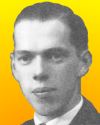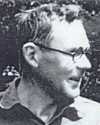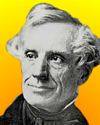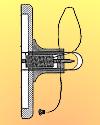 | TODAY IN SCIENCE HISTORY NEWSLETTER - 27 APRIL |
| Feature for Today |
 On 27 Apr 1846, Charles Joseph Van Depoele was born, a Belgian-American inventor who was one of the major contributors to the electric industry, especially in the field of transportation. On 27 Apr 1846, Charles Joseph Van Depoele was born, a Belgian-American inventor who was one of the major contributors to the electric industry, especially in the field of transportation.His 243 U.S. patents included motors, dynamos, lighting, electric railway systems, overhead trolley systems and underground railway systems. Other electrically powered mechanisms he designed included a conveyor, telpher system, rock drill, power-hammer and coal-mining machine. Despite such a productive life, and great significance in the electric industry of his era, perhaps now his name is unfamiliar to you. If so, you will enjoy reading more about his background and invention in this Obituary of Charles Joseph Van Depoele from the Transations of the American Institute of Electrical Engineers (1892). |
| Book of the Day | |
| |
| Quotations for Today | |
 | "Part of the strength of science is that it has tended to attract individuals who love knowledge and the creation of it. ... Thus, it is the communication process which is at the core of the vitality and integrity of science." |
 | "If a single cell, under appropriate conditions, becomes a man in the space of a few years, there can surely be no difficulty in understanding how, under appropriate conditions, a cell may, in the course of untold millions of years, give origin to the human race." |
| "All great scientists have, in a certain sense, been great artists; the man with no imagination may collect facts, but he cannot make great discoveries." | |
| QUIZ | |
| Before you look at today's web page, see if you can answer some of these questions about the events that happened on this day. Some of the names are very familiar. Others will likely stump you. Tickle your curiosity with these questions, then check your answers on today's web page. | |
| Births | |
 |  Wallace Carothers, born 27 Apr 1896, was an American chemist who developed polymers (long-chain molecules) including first successful synthetic rubber, neoprene (1931). He also produced (1935), the first synthetic polymer fibre to be spun from a melt, a polyamide. Wallace Carothers, born 27 Apr 1896, was an American chemist who developed polymers (long-chain molecules) including first successful synthetic rubber, neoprene (1931). He also produced (1935), the first synthetic polymer fibre to be spun from a melt, a polyamide. What is the common name of the polyamide he developed? What is the common name of the polyamide he developed? |
 |  The Morse Code was name after its American inventor, who was born 27 Apr 1791. Independent of similar efforts in Europe, he developed an electric telegraph (1832-35), after which he created his famous code in 1838. The Morse Code was name after its American inventor, who was born 27 Apr 1791. Independent of similar efforts in Europe, he developed an electric telegraph (1832-35), after which he created his famous code in 1838.  What is this inventor's first name? What is this inventor's first name? |
| Deaths | |
| |  Julius Sterling Morton (1832-1902) was an American who established a Day to be recognized in the U.S. to highlight a certain activity. It was first observed in Nebraska on 10 Apr 1872. Since 1885, the day has been also been celebrated in Nebraska as a public holiday on Morton's birthday in his honour. Julius Sterling Morton (1832-1902) was an American who established a Day to be recognized in the U.S. to highlight a certain activity. It was first observed in Nebraska on 10 Apr 1872. Since 1885, the day has been also been celebrated in Nebraska as a public holiday on Morton's birthday in his honour. By what name is this Day known? By what name is this Day known? |
| Events | |
 On 27 Apr 1970, the discovery of element 105, was announced at the American Physical Society meeting in Washington, D.C. The work was done by Albert Ghiorso at the Lawrence Radiation Laboratory at the University of California, Berkeley, California. It has been named hahnium. On 27 Apr 1970, the discovery of element 105, was announced at the American Physical Society meeting in Washington, D.C. The work was done by Albert Ghiorso at the Lawrence Radiation Laboratory at the University of California, Berkeley, California. It has been named hahnium. What is the origin of the name: hahnium? What is the origin of the name: hahnium? | |
 |  On 27 Apr of a certain year, the first U.S. patent for an electric hearing aid was issued, titled a Device for Aiding the Deaf to Hear. The device employed bone conduction by which sound is passed through vibration of the skull bone. It was not until two decades later that the first commercially available hearing aid was produced by another inventor. On 27 Apr of a certain year, the first U.S. patent for an electric hearing aid was issued, titled a Device for Aiding the Deaf to Hear. The device employed bone conduction by which sound is passed through vibration of the skull bone. It was not until two decades later that the first commercially available hearing aid was produced by another inventor.  In which decade was this first electric hearing aid U.S. patent issued? In which decade was this first electric hearing aid U.S. patent issued? |
| Answers |
When you have your answers ready to all the questions above, you'll find all the information to check them, and more, on the April 27 web page of Today in Science History. Or, try this link first for just the brief answers. Fast answers for the previous newsletter for April 26: a faint electromagnetic radiation throughout the universe with a frequency consistent with the mathematical predictions of the big bang model; Charles Richter; ammonia; the decade including the year 1961; Harlow Shapley. |
| Feedback |
 If you enjoy this newsletter, the website, or wish to offer encouragement or ideas, please send feedback by using your mail reader Reply button. If you enjoy this newsletter, the website, or wish to offer encouragement or ideas, please send feedback by using your mail reader Reply button. |
--
If you do not want to receive any more newsletters, Unsubscribe
To update your preferences and to unsubscribe visit this link


Δεν υπάρχουν σχόλια:
Δημοσίευση σχολίου